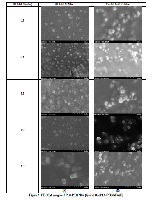Impact of PLA/PEG ratios on Curcumin solubility and encapsulation efficiency, size and release behavior of Curcumin loaded poly(lactide)-poly(ethylenglycol) polymeric micelles
Keywords:
Chemotherapy, Curcumin, Poly(lactide)-polyethylene glycol (PLA-PEG), copolymer, polymeric micelleAbstract
Curcumin, a natural compound isolated from rhizomes of the herb Curcuma longa, is suggested as a potential therapeutic agent thanks to its multiple biological and pharmaceutical activities including anti-inflammatory, anti-oxidant, wound healing, anti-microbial and anti-cancer activities. Particularly, Curcumin has demonstrated efficacy as an anticancer agent for various kinds of cancer. However, its low aqueous solubility and bioavailability hamper its clinical application. Therefore, many drug delivery systems have been developed to overcome these limitations. In this study, by using polymeric micelles composed by poly (lactide)-poly (ethylenglycol) (PLA-PEG) copolymers, the aqueous solubility of Curcumin was increased to 0.73 mg.mL-1 compared to 0.11ï10-4 mg.mL-1 of pure Curcumin. In addition, we found that the ratio of PLA/PEG has large impact on Curcumin solubility, Curcumin encapsulation efficiency, size and Curcumin release behavior of polymeric micelles. The increase in Curcumin solubility, Curcumin encapsulation efficacy and particle size but decrease in Curcumin release rate were observed when increasing the PLA/PEG ratio.
References
Maheshwari, R.K., et al., Multiple biological activities of curcumin: A short review. Life Sciences, 2006. 78(18): p. 2081-2087.
Duvoix, A., et al., Chemopreventive and therapeutic effects of curcumin. Cancer Lett, 2005. 223(2): p. 181-90.
Anand, P., et al., Curcumin and cancer: an "old-age" disease with an "age-old" solution. Cancer Lett, 2008. 267(1): p. 133-64.
Ravindran, J., S. Prasad, and B.B. Aggarwal, Curcumin and cancer cells: how many ways can curry kill tumor cells selectively? Aaps J, 2009. 11(3): p. 495-510.
Bava, S.V., et al., Sensitization of taxol-induced apoptosis by curcumin involves down-regulation of nuclear factor-kappaB and the serine/threonine kinase Akt and is independent of tubulin polymerization. J Biol Chem, 2005. 280(8): p. 6301-8.
Balaji, S. and B. Chempakam, Toxicity prediction of compounds from turmeric (Curcuma longa L). Food Chem Toxicol, 2010. 48(10): p. 2951-9.
Tønnesen, H.H., M. Másson, and T. Loftsson, Studies of curcumin and curcuminoids. XXVII. Cyclodextrin complexation: solubility, chemical and photochemical stability. International Journal of Pharmaceutics, 2002. 244(1–2): p. 127-135.
Yang, K.Y., et al., Oral bioavailability of curcumin in rat and the herbal analysis from Curcuma longa by LC-MS/MS. J Chromatogr B Analyt Technol Biomed Life Sci, 2007. 853(1-2): p. 183-9.
Naksuriya, O., et al., Curcumin nanoformulations: a review of pharmaceutical properties and preclinical studies and clinical data related to cancer treatment. Biomaterials, 2014. 35(10): p. 3365-83.
Xu, W., P. Ling, and T. Zhang, Polymeric Micelles, a Promising Drug Delivery System to Enhance Bioavailability of Poorly Water-Soluble Drugs. Journal of Drug Delivery, 2013. 2013: p. 15.
Deng, C., et al., Biodegradable polymeric micelles for targeted and controlled anticancer drug delivery: Promises, progress and prospects. Nano Today, 2012. 7(5): p. 467-480.
Miyata, K., R.J. Christie, and K. Kataoka, Polymeric micelles for nano-scale drug delivery. Reactive and Functional Polymers, 2011. 71(3): p. 227-234.
Ge, H., et al., Preparation, characterization, and drug release behaviors of drug nimodipine-loaded poly(epsilon-caprolactone)-poly(ethylene oxide)-poly(epsilon-caprolactone) amphiphilic triblock copolymer micelles. J Pharm Sci, 2002. 91(6): p. 1463-73.
Mahmud, A. and A. Lavasanifar, The effect of block copolymer structure on the internalization of polymeric micelles by human breast cancer cells. Colloids Surf B Biointerfaces, 2005. 45(2): p. 82-9.
Wan, Y., et al., Biodegradable poly(L-lactide)-poly(ethylene glycol) multiblock copolymer: synthesis and evaluation of cell affinity. Biomaterials, 2003. 24(13): p. 2195-203.
Tobı́o, M., et al., The role of PEG on the stability in digestive fluids and in vivo fate of PEG-PLA nanoparticles following oral administration. Colloids and Surfaces B: Biointerfaces, 2000. 18(3–4): p. 315-323.
Moghimi, S.M., A.C. Hunter, and J.C. Murray, Long-Circulating and Target-Specific Nanoparticles: Theory to Practice. Pharmacological Reviews, 2001. 53(2): p. 283-318.
Mikhail, A.S. and C. Allen, Poly(ethylene glycol)-b-poly(ε-caprolactone) Micelles Containing Chemically Conjugated and Physically Entrapped Docetaxel: Synthesis, Characterization, and the Influence of the Drug on Micelle Morphology. Biomacromolecules, 2010. 11(5): p. 1273-1280.
Hirenkumar, K.M. and J.S. Steven, Poly Lactic-co-Glycolic Acid (PLGA) as Biodegradable Controlled Drug Delivery Carrier. Polymers, 2011. 3(3).
Fonseca, C., S. Simoes, and R. Gaspar, Paclitaxel-loaded PLGA nanoparticles: preparation, physicochemical characterization and in vitro anti-tumoral activity. J Control Release, 2002. 83(2): p. 273-286.
Xiong, X.Y., K.C. Tam, and L.H. Gan, Release kinetics of hydrophobic and hydrophilic model drugs from pluronic F127/poly(lactic acid) nanoparticles. J Control Release, 2005. 103(1): p. 73-82.
Jeong, Y.-I., et al., Clonazepam release from core-shell type nanoparticles in vitro. Journal of Controlled Release, 1998. 51(2–3): p. 169-178.
Lavasanifar, A., J. Samuel, and G.S. Kwon, Poly(ethylene oxide)-block-poly(l-amino acid) micelles for drug delivery. Advanced Drug Delivery Reviews, 2002. 54(2): p. 169-190.
Gref, R., et al., Biodegradable long-circulating polymeric nanospheres. Science, 1994. 263(5153): p. 1600-3.





